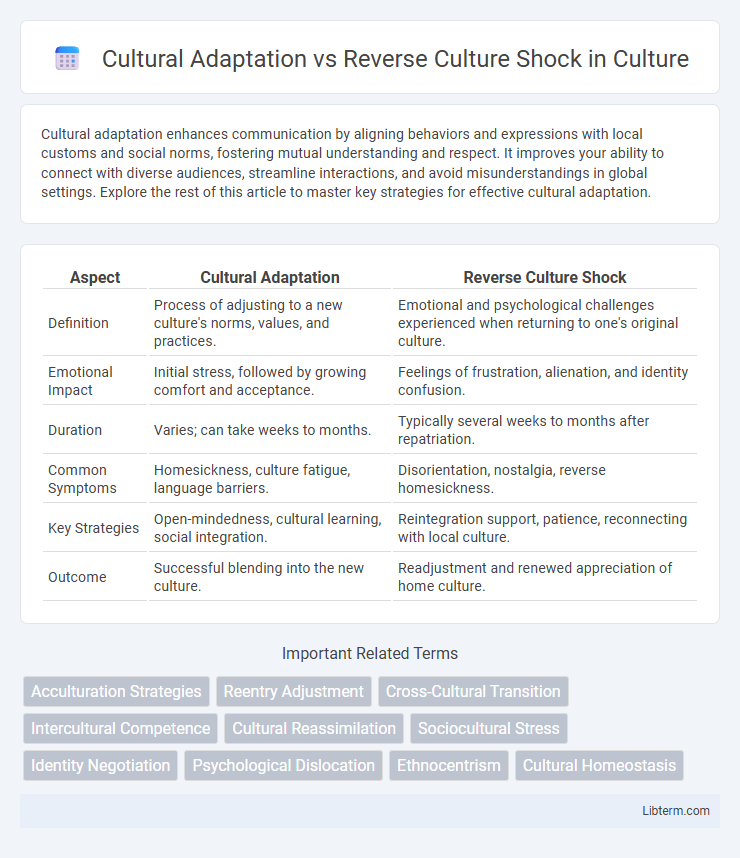Cultural adaptation enhances communication by aligning behaviors and expressions with local customs and social norms, fostering mutual understanding and respect. It improves your ability to connect with diverse audiences, streamline interactions, and avoid misunderstandings in global settings. Explore the rest of this article to master key strategies for effective cultural adaptation.
Table of Comparison
| Aspect | Cultural Adaptation | Reverse Culture Shock |
|---|---|---|
| Definition | Process of adjusting to a new culture's norms, values, and practices. | Emotional and psychological challenges experienced when returning to one's original culture. |
| Emotional Impact | Initial stress, followed by growing comfort and acceptance. | Feelings of frustration, alienation, and identity confusion. |
| Duration | Varies; can take weeks to months. | Typically several weeks to months after repatriation. |
| Common Symptoms | Homesickness, culture fatigue, language barriers. | Disorientation, nostalgia, reverse homesickness. |
| Key Strategies | Open-mindedness, cultural learning, social integration. | Reintegration support, patience, reconnecting with local culture. |
| Outcome | Successful blending into the new culture. | Readjustment and renewed appreciation of home culture. |
Understanding Cultural Adaptation
Cultural adaptation involves the process by which individuals adjust their behaviors, values, and communication styles to effectively engage within a new cultural environment. This adaptation enhances intercultural competence and promotes smoother social integration by bridging cultural differences. Successful cultural adaptation reduces misunderstandings and fosters respect for diverse cultural norms, enabling more meaningful cross-cultural interactions.
What is Reverse Culture Shock?
Reverse culture shock occurs when individuals returning to their home country experience difficulty readjusting to familiar environments after living abroad. This phenomenon often involves feelings of disorientation, frustration, and alienation as former routines and cultural norms no longer feel as comfortable or relevant. Understanding reverse culture shock is essential for effective reintegration and maintaining psychological well-being post-international experience.
Key Differences Between Adaptation and Reverse Shock
Cultural adaptation involves gradually adjusting to a new culture's norms, values, and behaviors, leading to increased comfort and effective functioning in the foreign environment. Reverse culture shock occurs when individuals return to their home culture and experience disorientation, frustration, or alienation due to changes in themselves or their surroundings. The key difference lies in the direction of adjustment: adaptation focuses on assimilating into a new culture, while reverse culture shock deals with re-adjusting to the original culture after an extended absence.
Stages of Cultural Adaptation
Cultural adaptation involves stages such as honeymoon, negotiation, adjustment, and mastery, where individuals gradually learn to navigate and integrate into a new cultural environment. Reverse culture shock occurs when returning to one's home country triggers feelings of disorientation, often mirroring the initial adjustment challenges but with stages including euphoria, irritation, gradual adjustment, and reentry adaptation. Understanding these stages helps individuals manage emotional responses and effectively transition between cultures.
Common Symptoms of Reverse Culture Shock
Reverse culture shock often manifests through symptoms such as frustration, disorientation, and feelings of isolation upon returning to one's home country after extended time abroad. Individuals may experience difficulty readjusting to familiar environments, encountering unexpected cultural misunderstandings and altered social dynamics. Physical complaints, including fatigue and irritability, frequently accompany emotional challenges during the reintegration process.
Psychological Impact on Returnees
Returnees often experience psychological distress during reverse culture shock, characterized by feelings of confusion, frustration, and loss of identity after re-entry into their home culture. Cultural adaptation abroad involves gradual acclimatization to new social norms and values, fostering cognitive flexibility and emotional resilience. The psychological impact on returnees includes difficulty reintegrating, as expectations clash with reality, often leading to anxiety, depression, and a need for social support systems to mitigate reverse culture shock effects.
Strategies for Effective Cultural Adaptation
Effective cultural adaptation strategies involve active listening, open-mindedness, and immersion in local customs to facilitate smoother integration into new environments. Developing cultural intelligence through language acquisition and social interactions reduces misunderstandings and enhances mutual respect. Maintaining flexibility and seeking support networks help mitigate reverse culture shock when re-entering one's home culture, enabling a balanced transition.
Coping Mechanisms for Reverse Culture Shock
Coping mechanisms for reverse culture shock involve reconnecting with familiar social networks and engaging in cultural activities that reinforce a sense of belonging. Practicing mindfulness and maintaining a journal can help individuals process conflicting emotions and identify sources of discomfort. Seeking professional support or joining support groups specifically designed for repatriates enhances adjustment by providing shared experiences and practical strategies.
Role of Community and Support Systems
Community and support systems play a crucial role in both cultural adaptation and reverse culture shock by providing emotional stability and practical guidance. During cultural adaptation, local networks help individuals navigate unfamiliar social norms and language barriers, fostering acceptance and integration. In contrast, during reverse culture shock, reconnecting with familiar but changed social environments is eased by strong support systems that validate experiences and ease re-adjustment to home culture.
Long-term Implications and Personal Growth
Cultural adaptation involves sustained changes in behavior and mindset as individuals immerse themselves in a new cultural environment, fostering long-term personal growth through increased cultural intelligence and emotional resilience. Reverse culture shock occurs when returning to one's original culture, often challenging previously adapted habits and triggering introspection, which can lead to enhanced self-awareness and improved cross-cultural communication skills. Both experiences contribute to a deeper understanding of identity and global perspectives, shaping lifelong intercultural competence.
Cultural Adaptation Infographic

 libterm.com
libterm.com